Category: gui
Python hosting: Host, run, and code Python in the cloud!
Matplot Matrix Correlation
A correlation diagram can be created using Matplotlib. Matplotlib is the most used plotting library for Python. It can be included in all the graphical toolkits that are available for Python.
Related courses
Matrix definition
To start we define a 2×2 matrix and a list called groups. The matrix is defined inside the brackets (double [[ and ]] if written on a single line).
m = [ [1,0,2,0,0], [1,1,1,2,0], [0,4,1,0,0], [0,4,4,1,2], [1,3,0,0,1], ] groups = ['Blues','Jazz','Rock','House','Dance'] |
Visual:
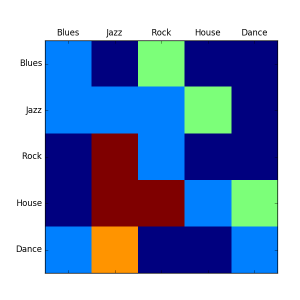
Matrix correlation
The code below generates a Matrix correlation diagram using Matplotlib.
import matplotlib.pyplot as plt import numpy as np m = [ [1,0,2,0,0], [1,1,1,2,0], [0,4,1,0,0], [0,4,4,1,2], [1,3,0,0,1], ] plt.matshow(m) groups = ['Blues','Jazz','Rock','House','Dance'] x_pos = np.arange(len(groups)) plt.xticks(x_pos,groups) y_pos = np.arange(len(groups)) plt.yticks(y_pos,groups) plt.show() |
Initially we define the matrix (m) and the list (groups).
We set the length to be equal to the length of the groups. On the x axis and y axis we set the group names.
wxPython window
wxPython is a GUI toolkit for the Python programming language. wxPython can be used to create graphical user interfaces (GUI).
Applications made with wxPython have a native appearance on all platforms. The application will appear as native application unlike QT or Tk which have a custom QT or Tk look. It runs on all major desktop platforms.
Currently supported operating systems are Microsoft Windows (32-bit), most Unix or unix-like systems, and Macintosh OS X.
You can view screenshots of applications made with wxPython.
The wxPython module is based on the C++ GUI library wxWidgets.
wxPython window
To open a window with wxPython, run the code below:
#!/usr/bin/python import wx app = wx.App() frame = wx.Frame(None, -1, 'win.py') frame.Show() app.MainLoop() |
The line wx.App() creates an application object. Each wx program needs to have one .App() object.
The method wx.Frame() returns a new window which can contain widgets.
app.Mainloop() puts the application in the main loop and listens for events.
Window size and position
You can set the position and size with the SetDimensions() function:
#!/usr/bin/python import wx app = wx.App() frame = wx.Frame(None, -1, 'win.py') frame.SetDimensions(0,0,640,480) frame.Show() app.MainLoop() |
The parameters of the function are: x (left), y (top), width and height. The function not only sets the screen resolution but also the position on the screen.
Center a window
To put the window in the center of the screen call:
frame.Centre() |
wxPython Buttons
To create a button simply call wx.Button(). When creating a button with wx.Button() it is important to parse the panel as first argument. We attach it to a panel because attaching to the frame would make it full screen.
A panel gives you to option to position widgets anywhere in the window. The parameter (10,10) is the position on the panel. The id argument is necessary, but it is equal to -1 (wx.ID_ANY == -1). The 3rd parameter is the text on the button.
You can use the code below to create a button in wxPython:
#!/usr/bin/python import wx def onButton(event): print "Button pressed." app = wx.App() frame = wx.Frame(None, -1, 'win.py') frame.SetDimensions(0,0,200,50) panel = wx.Panel(frame, wx.ID_ANY) button = wx.Button(panel, wx.ID_ANY, 'Test', (10, 10)) button.Bind(wx.EVT_BUTTON, onButton) frame.Show() frame.Centre() app.MainLoop() |
The function onButton() is called if the button is pressed. We bind (connect) it with button.Bind(wx.EVT_BUTTON, onButton).
Output:

Image on button
wxPython supports having images on buttons. Only a minor change is needed to display an image on a button. While the function is called wx.BitmapButton, it supports other image formats.
bmp = wx.Bitmap("call-start.png", wx.BITMAP_TYPE_ANY) button = wx.BitmapButton(panel, id=wx.ID_ANY, bitmap=bmp, size=(bmp.GetWidth()+10, bmp.GetHeight()+10)) |
The first line loads the image, the second line creates the button.
Full code:
#!/usr/bin/python import wx def onButton(event): print "Button pressed." app = wx.App() frame = wx.Frame(None, -1, 'win.py') frame.SetDimensions(0,0,200,70) panel = wx.Panel(frame, wx.ID_ANY) bmp = wx.Bitmap("call-start.png", wx.BITMAP_TYPE_ANY) button = wx.BitmapButton(panel, id=wx.ID_ANY, bitmap=bmp, size=(bmp.GetWidth()+10, bmp.GetHeight()+10)) button.Bind(wx.EVT_BUTTON, onButton) button.SetPosition((10,10)) frame.Show() frame.Centre() app.MainLoop() |
Output:

wxPython dialogs
To display a dialog with wxPython requires only a few lines of code. We will demonstrate that below:
Information dialog
An information dialog can be shown with one line of code:
import wx app = wx.App() wx.MessageBox('Pythonspot wxWidgets demo', 'Info', wx.OK | wx.ICON_INFORMATION) |
The first parameter is the actual text to display. The second is the title and final parameter tells wx to show the information icon and button.
Output:
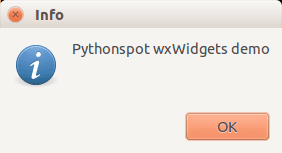
More dialogs: Warning dialog, Error dialog and default dialog
By modifying the parameters you can easily create other types of dailogs. An example below:
import wx app = wx.App() # simple dialog wx.MessageBox('A dialog', 'Title', wx.OK) # warning dialog wx.MessageBox('Operation could not be completed', 'Warning', wx.OK | wx.ICON_WARNING) # error dialog wx.MessageBox('Operation could not be completed', 'Error', wx.OK | wx.ICON_ERROR) |
Output (only one of the dialogs):
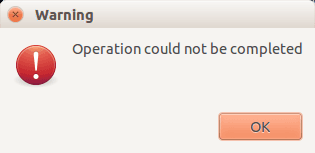
Question dialog
Wx can be used to create a question dialog (yes/no). Example code:
import wx app = wx.App() dlg = wx.MessageDialog(None, "Do you want to update?",'Updater',wx.YES_NO | wx.ICON_QUESTION) result = dlg.ShowModal() if result == wx.ID_YES: print "Yes pressed" else: print "No pressed" |
Output:
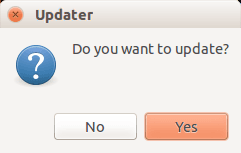
wxPython file dialog
Nearly every desktop application that can open one or more files has a file dialog.
An open file dialog may seem like a very complicated window to create: it contains buttons, locations, labels and many more widgets. Moreover, the appearance of this open file dialog looks different on every platform: Mac OS, Windows and so on.
The wxPython module comes with open file dialogs, which can be created with a few functions calls.
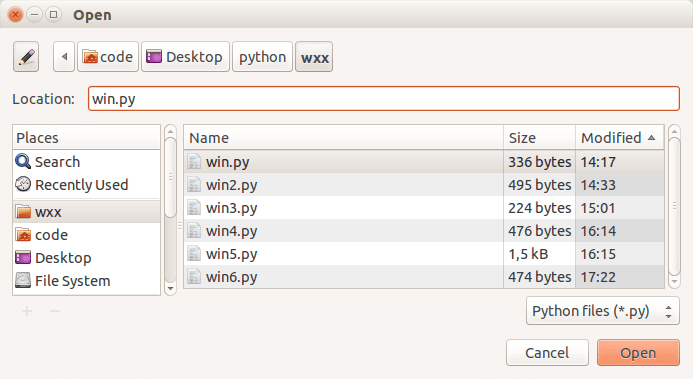
wxPython file dialog
The example below creates a file dialog with a native appearance using wxPython:
#!/usr/bin/python import wx def onButton(event): print "Button pressed." app = wx.App() frame = wx.Frame(None, -1, 'win.py') frame.SetDimensions(0,0,200,50) # Create open file dialog openFileDialog = wx.FileDialog(frame, "Open", "", "", "Python files (*.py)|*.py", wx.FD_OPEN | wx.FD_FILE_MUST_EXIST) openFileDialog.ShowModal() print(openFileDialog.GetPath()) openFileDialog.Destroy() |
To create a file dialog with wxPython we can simply call wx.FileDialog().
The definition of this method is: (parent, message, defaultDir, defaultFile, wildcard, style, pos)
We call this method with the arguments:
wx.FileDialog(frame, "Open", "", "","Python files (*.py)|*.py",wx.FD_OPEN | wx.FD_FILE_MUST_EXIST) |
(no default dir or default file is specified).
The method showModal() displays the window:
openFileDialog.ShowModal() |
The command openFileDialog.GetPath() returns the full path to the file if one is selected.
wxPython input dialog
Input dialogs let your user give you feedback or input. They appear in desktop applications once in a while.
wxPython supports input dialogs, they are included with the framework.
A typical wxPython dialog may look like:
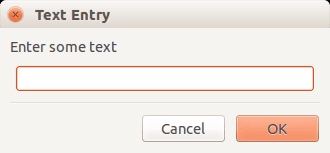
wxPython input dialog
The example code below creates an input dialog with wxPython:
#!/usr/bin/python import wx def onButton(event): print "Button pressed." app = wx.App() frame = wx.Frame(None, -1, 'win.py') frame.SetDimensions(0,0,200,50) # Create text input dlg = wx.TextEntryDialog(frame, 'Enter some text','Text Entry') dlg.SetValue("Default") if dlg.ShowModal() == wx.ID_OK: print('You entered: %s\n' % dlg.GetValue()) dlg.Destroy() |
A wxPython textbox can be added to a window using the function:
wx.TextEntryDialog(frame, 'Enter some text','Text Entry') |
Where the first argument is the frame, the second argument is the label and the last argument is the window title.
The function below displays the dialog and waits for a user to press one of the buttons:
dlg.ShowModal() |
You can get the button pressed by picking one of these:
wx.OK wx.CANCEL |
(the result is either one of these)
After input is been given, you can get the input text using dlg.GetValue() function.
